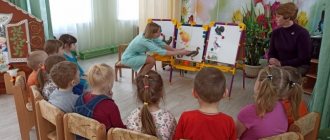Who is a defectologist
A defectologist is a correctional teacher who works with children with developmental disabilities. Despite the fact that the science of defectology developed at the intersection of medicine and pedagogy, this specialist is not a doctor. He is a special education teacher, and his main task is teaching and raising children with disabilities (disabilities).
Workers of this profile can be found not only in kindergartens and schools. They can be found in rehabilitation and social centers and clinics. He can work both with a specific child and with a group.
Defectology includes several branches:
- Oligophrenopedagogy - work with intellectual disabilities (mental retardation, mental retardation);
- Deaf pedagogy - work with hearing problems;
- Typhlopedagogy - work with visual impairments;
- Speech therapy - work with speech disorders.
The work of a defectologist in a kindergarten is very diverse and depends on specific disorders. You will rarely find this specialist in a regular school - he works in specialized schools for children with developmental disabilities. The school usually only has a speech therapist who deals with children with speech disorders.
Another important aspect of the work of a defectologist is the instillation of social and everyday skills. A child with intellectual disability does not adapt well to life, and blind people cannot navigate in space. A correctional teacher is called upon to help cope with this.
Structural model of defectological classesmaterial on the topic
Structural model of defectology classes:
1.Preparatory stage
Relieving stress, preparing for work
Declaration of goals and objectives
2.Main stage
"Brain gymnastics."
Performing exercises to improve brain activity and prevent visual impairment:
“head shaking” - the exercise stimulates thought processes;
“Lazy Eights” - the exercise activates the brain structures that ensure memorization and increases the stability of attention;
“Thinking cap” - exercise improves attention, clarity of perception and speech;
Corrective gymnastics for the eyes: blinking, “I see a finger”, “the finger doubles”.
3.Warm up
The main task of the stage is to create a certain positive emotional background for the children; fairly easy questions are included that can arouse interest, designed for intelligence and quick reaction.
Training of mental mechanisms underlying creative abilities: memory, attention, imagination, thinking. The tasks used at this stage of the lesson not only contribute to the development of the listed qualities, but also allow them to deepen the knowledge of children and diversify the methods and techniques of cognitive activity.
For the purpose of relaxation, exercises are used to relieve eye strain (I use Bazarny’s interactive techniques, the method of preventing visual fatigue and developing visual abilities by V.A. Kovalev), massage and self-massage (A.V. Semenovich “Neuropsychological correction in childhood. Method of replacement ontogenesis” . – M.: Genesis, 2007.)
4. Logical search tasks
At this stage, tasks from the field of mathematics are interspersed with tasks from the Russian language, etc. This alternation of tasks promotes the development of flexibility of thinking and forces you to find original, non-standard ways to get out of difficult situations.
5. “Fun recess”
A dynamic pause as part of a lesson develops not only the child’s motor sphere, but also the ability to perform several different tasks simultaneously.
6. “Non-standard tasks.”
The ability to navigate the text of a learning task is an important result and an important condition for the overall development of the student. But the problems that are in school textbooks are not enough. It is very important to teach children to solve non-standard problems, that is, problems whose topics are not in themselves the object of study. The tasks offered in this section differ not only in content, but also in complexity.
7.Final stage
Reflection
What kind of work does he do with children?
Teaches, educates, introduces them to the world around them, and more - this is what a defectologist does with children. This is not the most complete list of activities. They depend on the type of violation. The overall goal is to develop motivation for learning.
At the first stage, the teacher-defectologist conducts an examination. It affects all aspects of development. It is checked how children make contact, how they react, and what their pace of work is. Thinking, understanding of instructions, visual and auditory perception are examined.
Based on the results obtained, the teacher divides the children into groups. Pupils in them have approximately the same level of development. It is not possible to conduct group lessons with some children: autistic people fall into this category; these children are more often assigned to individual lessons due to the specific nature of this developmental disorder.
Classes are conducted in several directions:
- At the first stage, familiarization with the surrounding world is carried out. Ideas about it and its laws are formed. They develop attentiveness and responsibility for their actions.
- The second stage is the development of elementary mathematical concepts. During classes, the defectologist talks about the size, shape of objects and other characteristics.
Much attention is paid to sensorimotor development. Separate work is being carried out on the development of sensations. For this purpose, finger pools are made with various cereals and small toys. It is useful to prepare aromatic food, study vegetables, fruits, berries, touch them, examine them with your fingers. All this helps children develop different sensations.
Children with mental retardation have problems with games. It is difficult for them to contact someone and follow the rules. Therefore, they need the help of a speech pathologist. He competently guides the actions of his students and helps them find a common language with each other.
Consultations for parents are also indispensable. A defectologist can answer all their questions, give advice and help cope with the child’s problems.
How are classes with a defectologist?
Depending on the age of the child, classes have their own specifics. Let's tell you more about them.
From 1.5 to 3 years
Classes are aimed at teaching the child to communicate with adults, to play (play activity before entering school is the leading one), as well as to form sensory standards (color, shape, size), develop attention, memory, and thinking. With the help of special exercises and games, the defectologist develops auditory, tactile and visual perception.
From 3 to 5 years
Exercises and games are selected in such a way as to correct problematic behavior and create in the child a desire to explore the world around him. In addition, the defectologist teaches the child to navigate in space, perceive and correlate objects by color, size and shape, think logically, and concentrate on the task at hand. Particular attention is paid to the development of attention, memory, and the ability to analyze and synthesize information.
How can a defectologist help if a child has been seriously diagnosed?
Thanks to timely diagnosis and attentive attitude of parents, many serious disorders - mental retardation, autism and ASD, mental retardation can be identified early, at the age of 2.5-3 years. For such children and parents, the defectologist is the main teacher; it is he who builds an individual program of development, training and education, and socialization.
The child has mental retardation
Mental retardation is a disorder in which a number of higher mental functions (attention, thinking, emotional-volitional sphere, memory) mature later than expected by age. A defectologist has to solve several problems at once:
- development of attention, perception, speech, thinking, memory;
- teaching gaming activities;
- accumulation of sensory impressions;
- formation of knowledge about the surrounding world.
During classes, the teacher encourages the child’s creative activity by offering different options for tasks. As you progress, the learning material gradually becomes more complex.
The child has autism or ASD
The purpose of the classes is to compensate for deficiencies in the baby’s development that were identified during the examination. During diagnosis, the defectologist evaluates the following points:
- whether the child can imitate an adult and act according to verbal instructions;
- is he able to draw up an action plan and follow it;
- does he distinguish objects by color, shape, size;
- how developed are the motor and sensory areas;
- does the child confidently navigate in space, can he name and show parts of the body;
- how quickly the baby learns information, whether he can switch from one task to another, and whether he avoids participation;
- how the child behaves when communicating, how he reacts to the need to participate in the conversation.
As we have already said, exercises and games are selected to overcome identified developmental deficiencies. Classes with a speech pathologist are an important part of the correction program.
The child has mental retardation
Correctional training is carried out in several directions at once:
- development of the emotional-volitional sphere, attention, memory, imagination;
- development of all types of thinking;
- accumulation of knowledge about the world around us, replenishment of vocabulary, development of speech;
- sensorimotor development.
Classes with a defectologist are of an applied nature, that is, the child learns independence and masters communication skills with peers and adults.
Examples of working methods
The educational process is based on the characteristics of the disorder. For example, with hearing problems, oral speech decays. This is especially true for preschool age, since during this period there is an active formation of speech.
Hearing loss and lack of normal communication lead to the baby becoming silent. In the absence of proper correctional support, he loses the skill forever. Later he is taught sign language, but this greatly limits his ability to integrate into society.
Adaptation to real life is what a defectologist does in kindergarten and school. The teacher of the deaf focuses on the development of oral speech. The typhlopedagogue has to teach in a slightly different way. Its main task is the development of social and everyday skills. It is important to teach ideas about the world around us, to teach students to perceive the world “through their fingers.”
For this purpose, special voluminous books are created. They are made of different materials and depict: buildings, streets, animals, plants. All this allows students with visual impairments to form ideas about the world around them.
It is important to instill self-care skills, since sometimes parents do not allow their child to do this, depriving him of the chance for an independent life. Closer to school, preparation for mastering Braille begins. This is a raised dot pattern, which is analogous to regular writing. The blind perceive it through their fingers and read what is written.
Oligophrenopedagogues work with children with intellectual disabilities. This is mental retardation and mental retardation. Working with such students is based on the development of thinking. They are also taught self-service and communication skills. Children with mild mental retardation are taught to work.
Structure of a defectology lesson
Structural model of defectology classes:
1.Preparatory stage
Relieving stress, preparing for work
Declaration of goals and objectives
2.Main stage
"Brain gymnastics."
Performing exercises to improve brain activity and prevent visual impairment:
“head shaking” - the exercise stimulates thought processes;
“Lazy Eights” - the exercise activates the brain structures that ensure memorization and increases the stability of attention;
“Thinking cap” - exercise improves attention, clarity of perception and speech;
Corrective gymnastics for the eyes: blinking, “I see a finger”, “the finger doubles”.
3.Warm up
The main task of the stage is to create a certain positive emotional background for the children; fairly easy questions are included that can arouse interest, designed for intelligence and quick reaction.
Training of mental mechanisms underlying creative abilities: memory, attention, imagination, thinking. The tasks used at this stage of the lesson not only contribute to the development of the listed qualities, but also allow them to deepen the knowledge of children and diversify the methods and techniques of cognitive activity.
For the purpose of relaxation, exercises are used to relieve eye strain (I use Bazarny’s interactive techniques, the method of preventing visual fatigue and developing visual abilities by V.A. Kovalev), massage and self-massage (A.V. Semenovich “Neuropsychological correction in childhood. Method of replacement ontogenesis” . – M.: Genesis, 2007.)
4. Logical search tasks
At this stage, tasks from the field of mathematics are interspersed with tasks from the Russian language, etc. This alternation of tasks promotes the development of flexibility of thinking and forces you to find original, non-standard ways to get out of difficult situations.
5. “Fun recess”
A dynamic pause as part of a lesson develops not only the child’s motor sphere, but also the ability to perform several different tasks simultaneously.
6. “Non-standard tasks.”
The ability to navigate the text of a learning task is an important result and an important condition for the overall development of the student. But the problems that are in school textbooks are not enough. It is very important to teach children to solve non-standard problems, that is, problems whose topics are not in themselves the object of study. The tasks offered in this section differ not only in content, but also in complexity.
7.Final stage
Reflection
Problems of defectology
In modern conditions, not all persons with disabilities receive assistance. There are children with a complex structure of the defect, for example, deaf-blind. Until the last century, they were all considered unteachable, until the famous American teacher Anne Sullivan showed an example of teaching such a child. It is her photograph that is the title of this article.
Her student, Helen Keller, lost the ability to hear and see after a serious illness. The girl's fate was unenviable - an orphanage. But Sullivan has proven that it can be adapted to society. Keller became an activist, writer, and lecturer. Her activities were widely publicized in society. However, in the modern world, teaching such children is associated with a number of difficulties.
The increased number of children with autism spectrum disorder (ASD) requires speech pathologists to develop new training programs. In the last century they were considered mentally retarded, but modern research has refuted this. Work with such children should be aimed at developing communication skills.
To summarize, we can say that a defectologist carries out extremely complex, but very important work. Important for both the baby and his parents. This allows children to be socialized as much as possible in society.






